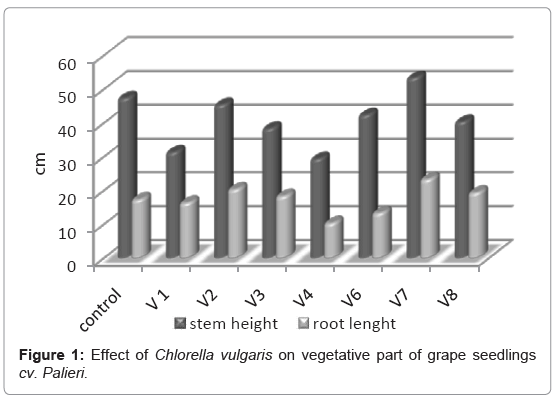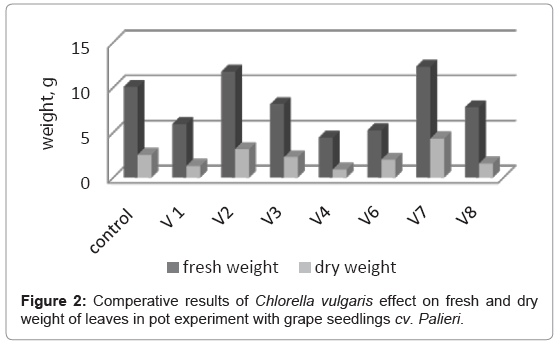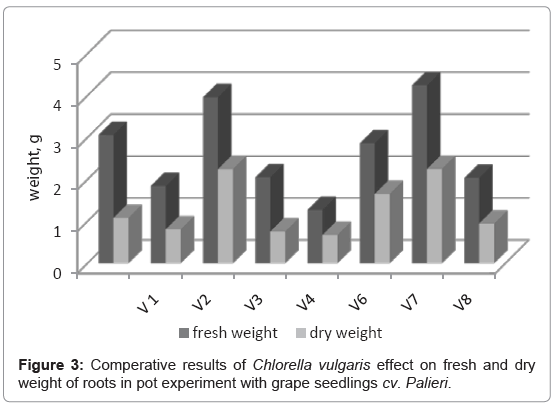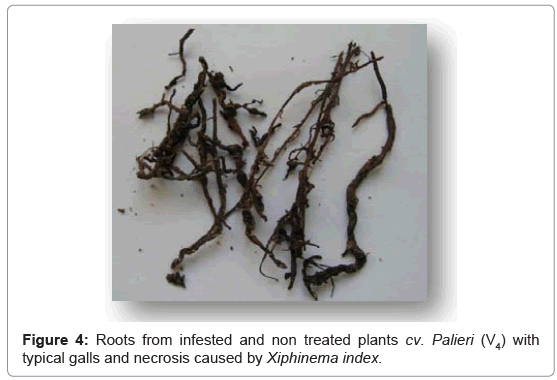Influence of Green Algae Chlorella vulgaris on Infested with Xiphinema index Grape Seedlings
Received: 23-Mar-2013 / Accepted Date: 26-Apr-2013 / Published Date: 30-Apr-2013 DOI: 10.4172/2157-7617.1000136
Abstract
Plant-parasitic nematodes are considered a major pest in grape growing countries. The present study was conducted during June-November 2007. The aim of the pot experiments was to establish the impact of dry extract of Chlorella vulgaris on the ungrafted grapevine seedlings cv.“Palieri” infested with root ectoparasite Xiphinema index. Different dosages of Chlorella (0.5, 1.0, 2,0 g per plant/pot) were investigated. The results show a decrease in the number of X. index in the variants treated with 1g Chlorella. There has been a positive effect on the growth characteristics of the test plants at the same concentrations. The green algae Chlorella vulgaris as a powerful phytoprotector have strong stimulating effect on the plant growth.
Keywords: Plant-parasitic nematodes; Xiphinema index; Chlorella vulgaris; phytoprotector
9555Introduction
Vitis vinifera is a crop grown all over the world especially in countries with Mediterranean and temperate climate. Vines have a great economic importance as one of the most popular plants in Bulgaria along with the vegetable crops. Grape plays an important role in European economics as an export goods and raw material for the production of wine and alcoholic drinks. It is well known that grapevine has different pests caused damage of the roots and leaves. Several nematode species are associated with grapevine roots. The most important being the ectoparasites from genus Xiphinema and some endoparasites from genus Meloidogyne.
The dagger nematode, Xiphinema index, is considered a major pest in grape growing countries. This nematode species is especially important because of its capability to transmit Grapevine Fan Leaf Virus (GFLV). Xiphinema index feeding on grapevine roots initially causes swollen club-like gall on root tips, which varies in size depends with the size and vigor of the root. Common symptoms of X. index feeding are plant stunting, chlorosis, root swellings or galls and root necrosis. Penetration of root by nematode stylet also makes them more susceptible to root-rotting fungi and GFLV which contribute to vine death [1]. In our country the damage of plant-parasitic nematodes of the family Longidoridae lead to 13% losses in vineyards [2].
The search for new pest control methods based on bioantagonist (the use of microorganisms, trap fungi or rhizobacteria) is an important aspect of sustainable agriculture [3]. Different control strategies are used for nematode management. Traditional control methods are based in the use of nematicides which are soil pollutants and also expensive. Some integrated managements includes crop rotations, use of amendments [4-6] and resistant rootstocks [7]. The use of different rootstocks is a good alternative, especially under replant conditions. But there is problem - most of these rootstocks are tolerant only to one or two nematode genera and sensitive to the other plant-parasitic nematodes present in soil and may also display high variability in different fields [8].
In the last few years, in Bulgaria, the priority is given to organic products and bio fertilizers (Johnson grass extract, vermicompost, Humustim etc.) that used for pest control and improving the plant growth in the variety of crops (orchards and fruits) with special emphasis on vegetables for direct human consumption [9-13]. These bio-products are safe for human, animals and environment.
Chlorella vulgaris, the object of this study is characterized with specific growing factor - “Growing factor Chlorella” which is proved as very potent immune-stimulator in living organisms. Because of high content in Chlorella of protein, amino acids, antioxidants, micro and macro elements and etc. its application has beneficial effect in some serious illnesses of people. The green algae Chlorella vulgaris refer to a group of powerful phyto-protectors. There is some data in the literature related to the effect of Chlorella as organic fertilizer on plants growth and yield [14-16] or plant-parasitic nematodes [6,17-20].
The aim of the study was to establish the effect of the green alga Chlorella vulgaris on the growth of test plants (grapevine cv. Palieri) and it influence on root ectoparasite Xiphinema index.
Materials and Methods
Algae
Green algae Chlorella vulgaris is grown near Petrich in South-West Bulgaria [21]. For the test dry extract of Chlorella vulgaris produced by “Golden apple”- Plamen Barakov is used. The trials included applying of 0.5g, 1.0g and 2.0g algae per plant/pot dissolved in 100ml water. The plants were watered once with solution.
Nematode extraction
The nematodes were taken from rhizosphere of naturally infested with Xiphinema index productive grapevines in the region of Pomorie town -South-East Bulgaria (42.55°N 27.65°E). They are placed in a pot with Ficus carica for artificial multiplication during 2 years.
For the experiment the nematodes were extracted from soil by Cobb’s sieving and gravity method [22] in combination with Baermann funnel method. Soil sieving (2mm, 150μm и 63μm) were using and a 48h decanting period through a Baermann funnel. Counting of nematodes from species Xiphinema index was carried out with stereoscopic microscope.
Plant material
Ungrafted grapevine seedlings cv. Palieri with identical growth cultivated in posts with 1000 cm3 sterilized soil.
Experimental work
The study was conducted during June-November 2007 in Laboratory of Zoology, Department of Ecology & Environmental protection at Agricultural University of Plovdiv. Eight-variance experiment (Table 1) with ungrafted grapevine seedlings cv. Palieri (a plant per pot in three repetitions) and X. index was carried out during 6 months. Numbers of X. index in the infested variants are calculated on the base of six specimens /100 cm3 soil - this is the minimum number of nematodes for Bulgarian population of X. index that cause damage to the roots of the vine found by Choleva [23].
| Variants | Xiphinema index | Chlorella vulgaris (g) |
|---|---|---|
| V1 (infested and treated plants) | + | 0.5 |
| V2 (infested and treated plants) | + | 1.0 |
| V3 (infested and treated plants) | + | 2.0 |
| V4 (infested and non treated plants) | + | - |
| V5 (uninfested and non treated plants) | - | - |
| V6 (uninfested and treated plants) | - | 0.5 |
| V7 (uninfested and treated plants) | - | 1.0 |
| V8 (uninfested and treated plants) | - | 2.0 |
Table 1: Study variants of influence of Chlorella vulgaris on infested with X. index grape seedlings cv. Palieri in pot experiment.
Morphological data -plant height, root length, fresh and dry weight were analyzed. At the end of experiment the Final nematode Population (FP) was recorded. Data were analyzed using the single factor analyze for field experiment by BIOSTAT program (ANOVA) [24].
Results and Discussion
The results showed that the test plants from V4 (infested and non treated) were with a poorly developed vegetative part, in comparison with control variant (V5 - uninfested and non treated plants) - (Table 2 and Figures 1-3). The grape seedings have greatly reduced roots, with coral like malformation and typical initial necrosis caused by obligate ectoparasites Xiphinema index (Figure 4).
| Variants | Plant height/cm | Root length/cm | Fresh weight/g | Dry weight/g | ||
|---|---|---|---|---|---|---|
| Leaves | Roots | Leaves | Roots | |||
| Control (uninfested and non treated plants) V5 | 47 | 17 | 10.929 | 3.066 | 2.562 | 1.084 |
| V1(X. index + 0.5g Chlorella) | 31 | 16 | 5.947 | 1.847 | 1.297 | 0.811 |
| V2 (X. index + 1g Chlorella) | 45 | 20 | 11.757 | 6.190 | 3.179 | 2.699 |
| V3(X. index + 2g Chlorella) | 38 | 18 | 8.153 | 2.334 | 2.275 | 0.758 |
| V4(infested with X. index and non treated plants) | 29 | 10 | 4.435 | 1.277 | 0.896 | 0.677 |
| V6 (uninfested +0.5g Chlorella) | 42 | 13 | 5.261 | 2.864 | 2.001 | 1.656 |
| V7(uninfested + 1g Chlorella) | 53 | 23 | 12.298 | 4.249 | 4.348 | 2.253 |
| V8 (uninfested + 2g Chlorella) | 40 | 19 | 7.722 | 2.308 | 1.561 | 0.689 |
| GD 5 % GD 1% GD 0.1 % |
3.600 4.884 6.555 |
2.632 3.571 4.793 |
2.361 3.204 4.300 |
1.753 2.378 3.190 |
0.789 1.071 1.438 |
0.897 1.218 1.634 |
Table 2: Morphological characteristics of un-grafted grape seedlings cv. Palieri in pot experiment.
Strong stimulating effect of algae on growth of test plants were observed in the variants with 0.5g and 1.0g Chlorella in comparison with the control variants (V4 -infested and non treated plants and V5 - uninfested and non treated plants). Application of Chlorella vulgaris at 1g significantly was accompanied with improving plant development (V7 - uninfested + 1g Chlorella) (Table 2 and Figure 1) and decreasing final nematode population (V2 - infested and treated plants). The results are close to the result of the free control V5 (Figures 1 and 2)
A phytotoxic effect in the variant with 2g Chlorella V8 (uninfested + 2g Chlorella) was observed (Figures 2 and 3). The plants are not fully grown, with least developed vegetative part and roots, with morphometric parameters close to the control variant. These results are in harmony with those obtained by [17,19,20].
Clearly positive impact on reducing the number of obligate ectoparasite X. index was observed in concentration 1g (V2 - infested and treated plants) with FP=21 sp./Pot) in comparison with IP=65 sp. /pot. High increase in numbers of dagger nematodes more than three times in comparison with initial population were recorded in infested control (V4 ) FP=214 sp./pot. There is a weak suppression of X. index FP=43 sp./pot in application of 0.5 g Chlorella (V1 ).
Conclusions
According to the results obtained in this study, it may be concluded that:
• Strong stimulating effect on growth was recorted in the treatments of plants with 1g Chlorella vulgaris (V2 and V7 ). Chlorella in this concentration (1g) has suppressing effect on root ectoparasite Xiphinema index.
• Chlorella vulgaris at low doses stimulates growth of grapes consisting in etiolating of the vegetative part.
• It was found that the concentration of 2g of Chlorella has phytotoxic effect on the vines.
• Chlorella vulgaris is a growth promoter for grapevine seedlings.
It is recommended to farmers that organic fertilizer Chlorella vulgaris should be included in technology for replanting of old vineyards, with special attention to areas threatened by the presence of dangerous pathogen Xiphinema index vector of GFLV.
References
- Van Zyl S, Vivier MA, Walker MA (2012) Xiphinema index and its Relationship to Grapevines: a review. S Afr Enol Vitic 33: 21-32.
- Choleva B (2000) Course in plant Nematology. Faculty of Biology, Sofia 158 (in Bulgarian)
- Aballay E, MÃ¥rtensson A, Persson P (2011) Screening of rhizosphere bacteria from grapevine for their suppressive effect on Xiphinema index Thorne & Allen on in vitro grape plants. Plant and Soil 347: 313-325.
- Aballay E, Sepulveda R, Insunza V (2004) Evaluation of five nematode - antagonistic plants used as green manure to control Xiphinema index Thorne et Allen on in Vitis vinifera L. 34: 48-50.
- Bileva T (2013) Influence of organic products on infested with Xiphinema index grapevines. Journal of Agricultural Science and Forest Science, Ecology and Future 12: 19-23 (in Bulgarian).
- Bileva T, Yancheva S, Choleva B (2007) Opportunities for the use of Chlorella vulgaris as organo-biological means to control Xiphinema index. Proceedings of Scientific conference for students, PhD students and young scientists “Five years Federation of Education & Science†Technical University, Plovdiv 1: 188-192 (in Bulgarian).
- Fajardo M, Aballay E, Casanova MP (2011) Soil properties influencing phytoparasitic nematode population on Chilian vineyards. Chilean Journal of Agricultural Research 2: 240-248.
- Ciancio A, Mujerji KG (2009) Integrated Management of Fruit Crops and Forest Nematodes. Integrated Management of Plant Pests and Diseases, Springer Science+Business Media LLC 4: 195–214.
- Haytova D (2009) Effect of foliar fertilization with Humustim on the productivity of zucchini squash. Proceedings of University of Rouse “Angel Kanchev†48: 17-21 (in Bulgarian).
- Haytova D (2012) Influence of foliar fertilization on the vegetative behaviors of zucchini squash (Cucurbita pepo L. var. giromontia), Science&Technologies 2: 61-66 (in Bulgarian).
- Dintcheva TSV, Boteva HR, Dimov I (2009) Influence of biofertilizers on productivity of tomatoes, midearly production in open field. Agricultural science, Plant studies 1: 557-561 (In Bulgarian).
- Panayotov N, Sapundhzieva KR, Kartalska Y, Dimitrov D (2004) Effect of bio fertilizer-compost from worm on the development of tomato seedling and on the rhizosphere microflora. Scientific work of Agricultural University of Plovdiv 49: 77-82 (in Bulgarian).
- Panayotov N, Kostadinova P, Stancheva N (2006) Influence of alelochemicals from Johnson grass extract on the sowing quality of carrot seeds in organic agriculture system. Journal of Environmental Protection and Ecology. Official Journal of the Balkan Environmental Association 7: 570- 573.
- Abd El Moniem-Eman A, Abd-Allah ASE (2008) Effect of green alga cell extract as foliar spray on vegetative growth, yield and berries quality of superior grapevines. American-Eurasian J Agric & Environ Sci 4: 427-433.
- Abd El-Moniem-Eman A, Abd-Allah ASE, Ahmed MA (2008) The Combined Effect of Some Organic Manures, Mineral N Fertilizers and Algal Extract on Yield and Fruit Quality of Williams Banana Plants. Am-Euras J Agric & Environ Sci 4: 417-426.
- Faheed FA, El-Fattah ZA (2008) Effect of Chlorella vulgaris as bio-fertilazer on growth parameters and metabolic aspects of lettuce plant. J of Agric & Soc Sci 4: 165-169.
- Choleva B, Bileva T, Tzvetkov Y, Barakov P (2005) Preliminary study of the green algae Chlorella (Chlorella vulgaris) for control on the root-knot nematode (Meloidogyne arenaria) in tomato plants and ectoparasite Xiphinema index in grape seedlings. Commun Agric Appl Biol Sci 4: 915-926.
- Choleva B, Tzvetkov Y, Bileva T, Barakov P (2006) Influence of the green algae chlorella (Chlorella vulgaris) on the root-knot nematode (Meloidogyne arenaria) under greenhouse condition. Journal of Environmental Protection and Ecology 2: 357-360.
- Choleva B, Bileva T, Tzvetkov J (2007) Organo-biological means and methods for control of plant parasitic nematodes as alternative of agrochemicals. Ecology and Future 4: 43-49.
- Yancheva S, Bileva T (2006) In vitro test for establishing of Chlorella vulgaris effect on grape infested with Xiphinema index. Field Crop Studies 3: 637-640 (in Bulgarian).
- Dilov CV (1985) Microalgae. Mass cultivation and use. BAS, Sofia 194 (in Bulgarian).
- Cobb NA (1918) Estimating the nema population of soil. USDA Agric Technol Circ II: 40.
- Choleva B (1994) Study of the nematodes from family Longidoridae of agricultural crops in Bulgaria. Dissertation for DSc 304 (in Bulgarian).
- Dimova D, Marinkov E (1999) Experimental work and biometrics. HAI - Plovdiv 263 (in Bulgarian).
Citation: Bileva T (2013) Influence of Green Algae Chlorella vulgaris on Infested with Xiphinema index Grape Seedlings. J Earth Sci Climate Change 4: 136. DOI: 10.4172/2157-7617.1000136
Copyright: ©2013 Bileva T. This is an open-access article distributed under the terms of the Creative Commons Attribution License, which permits unrestricted use, distribution, and reproduction in any medium, provided the original author and source are credited.
Select your language of interest to view the total content in your interested language
Share This Article
Recommended Journals
Open Access Journals
Article Tools
Article Usage
- Total views: 16876
- [From(publication date): 5-2013 - Dec 06, 2025]
- Breakdown by view type
- HTML page views: 11816
- PDF downloads: 5060




